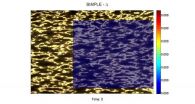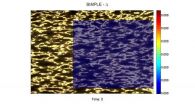(Press-News.org) VIDEO:
As a piece of plastic wrap is stretched, the new algorithms identify the location (in red) where it is weakening, which is where the material eventually breaks.
Click here for more information.
Researchers at Washington University in St. Louis have developed algorithms to identify weak spots in tendons, muscles and bones prone to tearing or breaking. The technology, which needs to be refined before it is used in patients, one day may help pinpoint minor strains and tiny injuries in the body's tissues long before bigger problems occur.
The research is available online Aug. 27 in the Journal of the Royal Society Interface, which publishes research at the nexus of the physical and life sciences.
"Tendons are constantly stretching as muscles pull on them, and bones also bend or compress as we carry out everyday activities," said senior investigator Stavros Thomopoulos, PhD, professor of orthopaedic surgery. "Small cracks or tears can result from these loads and lead to major injuries. Understanding how these tears and cracks develop over time therefore is important for diagnosing and tracking injuries."
To that end, Thomopoulos and his colleagues developed a way to visualize and even predict spots where tissues are weakened. To accomplish this, they stretched tissues and tracked what happened as their shapes changed or became distorted.
The paper's first author, John J. Boyle, a graduate student in biomedical engineering, combined mechanical engineering fundamentals with image-analysis techniques to create the algorithms, which were tested in different materials and in animal models.
"If you imagine stretching Silly Putty or a swimming cap with a picture on it, as you pull, the picture becomes distorted," Boyle said. "This allows us to track how the material responds to an external force."
In one of the experiments described in the paper, Boyle sprayed a pattern of dots on plastic wrap, stretched it and tracked the dots.
"As you pull and stretch the plastic wrap, eventually tears begin to emerge," he explained. "The new algorithm allowed us to find the places where the tears were beginning to form and to track them as they extended. Older algorithms are not as good at finding and tracking localized strains as the material stretches."
In fact, one of the two new algorithms is 1,000 times more accurate than older methods at quantifying very large stretches near tiny cracks and tears, the research showed. And a second algorithm has the ability to predict where cracks and failures are likely to form.
"This extra accuracy is critical for quantifying large strains," said Guy Genin, PhD, professor of mechanical engineering and co-senior investigator on the study. "Commercial algorithms that estimate strain often are much less sensitive, and they are prone to detecting noise that can arise from the algorithm itself rather than from the material being examined. The new algorithms can distinguish the noise from true regions of large strains."
Thomopoulos, who also is a professor of biomedical engineering and of mechanical engineering, works with Genin to study the shoulder's rotator cuff, a group of tendons and muscles that connect the upper arm to the shoulder blade. They want to learn why some surgeries to repair rotator cuff injuries ultimately fail. Their goal is to increase the odds that the tissue in the shoulder will heal following surgery, and they believe the new algorithms could help them get closer to that goal.
How soon the new algorithms could be used in patients depends on getting better images of the body's tissues. Current imaging techniques, such as MRI and ultrasound, lack the required clarity and resolution.
Genin also explained that although the goal of the current study is to better understand how forces at work on human tissue cause injury and stress, the algorithms also could help engineers identify vulnerable parts of buildings and other structures. Our muscles and bones, he said, are influenced by the same strains that affect those structures.
"Whether it's a bridge or a tendon, it's vital to understand the ways that physical forces cause structures and tissues to deform so that we can identify the onset of failures and eventually predict them," he said.
In the long run, they want to use the algorithms to prevent additional injuries following surgery to repair knees, shoulders and other tissues. They also said it may be possible some day to predict problems before they occur.
The group, which applied for a provisional patent earlier this year, hopes the algorithms will be useful to researchers in the medical and engineering fields.
INFORMATION:
This work was funded by the National Institute on Arthritis and Musculoskeletal and Skin Diseases (NIAMS) of the National Institutes of Health (NIH) and the National Science Foundation (NSF). NIH grant number U01EB016422.
Boyle JJ, Kume M, Wyczalkowski MA, Taber LA, Pless RB, Xia Y, Genin GM, Thomopoulos S. Simple and accurate methods for quantifying deformation, disruption and development in biological tissues. Journal of the Royal Society Interface, vol. 11 (100) 20140685. http://dx.doi.org/10.1098/rsif.2014.0685, published online Aug. 27, 2014.
Washington University School of Medicine's 2,100 employed and volunteer faculty physicians also are the medical staff of Barnes-Jewish and St. Louis Children's hospitals. The School of Medicine is one of the leading medical research, teaching and patient-care institutions in the nation, currently ranked sixth in the nation by U.S. News & World Report. Through its affiliations with Barnes-Jewish and St. Louis Children's hospitals, the School of Medicine is linked to BJC HealthCare.
The School of Engineering & Applied Science at Washington University in St. Louis focuses intellectual efforts through a new convergence paradigm and builds on strengths, particularly as applied to medicine and health, energy and environment, entrepreneurship and security. With 91 tenured/tenure-track and 40 additional full-time faculty, 1,300 undergraduate students, 750 graduate students and more than 23,000 alumni, we are working to leverage our partnerships with academic and industry partners — across disciplines and across the world — to contribute to solving the greatest global challenges of the 21st century.
New technology may identify tiny strains in body tissues before injuries occur
2014-08-27
ELSE PRESS RELEASES FROM THIS DATE:
New estrogen-based compound suppresses binge-like eating behavior in female mice
2014-08-27
HOUSTON – (Aug. 26, 2014) – Binge eating, an eating disorder in which a person frequently consumes unusually large amounts of food in a short period of time, affects about 5 to 10 percent of U.S. adults and is more common in women than men. Researchers at the USDA/ARS Children's Nutrition Research Center at Baylor College of Medicine and Texas Children's Hospital found that the hormone estrogen can specifically trigger brain serotonin neurons to inhibit binge eating in female mice in a report today in the Journal of Clinical Investigation.
"Previous data has shown that ...
Researchers discover fever's origin
2014-08-27
Fever is a response to inflammation, and is triggered by an onset of the signaling substance prostaglandin. Researchers at Linköping University in Sweden can now see precisely where these substances are produced – a discovery that paves the way for smarter drugs.
When you take an aspirin, all production of prostaglandins in the body is suppressed. All symptoms of inflammation are eased simultaneously, including fever, pain and loss of appetite. But it might not always be desirable to get rid of all symptoms – there is a reason why they appear.
"Perhaps you want to inhibit ...
Tumor blood vessel protein provides potential therapeutic target
2014-08-27
Tumor blood vessels supply oxygen and nutrients to cancer cells and provide access to other organs. While tumor vasculature shares many features with normal vessels, their unique characteristics are potential therapeutic targets. A recent study in the Journal of Clinical Investigation identifies a tumor vessel-specific protein, L1 that can be targeted to reduce tumor growth. Using a mouse pancreatic cancer model, Ugo Cavallaro and colleagues at the European Institute of Oncology found that loss of L1 reduced tumor blood vessel formation, which inhibited growth and metastasis. ...
Targeting estrogen receptors prevents binge eating in mice
2014-08-27
Binge easting disorder affects approximately 5% of adults in the US. Left unchecked, this disorder leads to health complications, including obesity, hypertension, and diabetes. The cause of this disease is poorly understood and treatment options are limited. A new study in the Journal of Clinical Investigation suggests that estrogen replacement may limit binge-eating behaviors. Using a mouse binge-eating model, Yong Xu and colleagues at Baylor School of Medicine found that estradiol suppressed binge eating behaviors. This effect required the presence of estrogen receptors ...
Young children's sipping/tasting of alcohol reflects parental modeling
2014-08-26
A new study examines antecedent predictors of childhood initiation of sipping or tasting alcohol.
Findings indicate that initiation of sipping/tasting was less related to psychosocial proneness for problem behavior and more related to perceived parental approval for child sipping.
Previous research had determined that whether or not a child sips or tastes alcohol is associated with the child's attitude toward sipping and with a family environment supportive of alcohol use. This study extends this former research to examine antecedent predictors of childhood initiation ...
Prenatal alcohol exposure is associated with later excess weight/obesity during adolescence
2014-08-26
Growth deficiency is a defining feature of Fetal Alcohol Spectrum Disorders (FASD).
A new study has found that rates of excess weight/obesity are elevated in adolescents with partial fetal alcohol syndrome (pFAS).
Females with FASD may be at a greater risk for excess weight/obesity than males during adolescence.
Fetal Alcohol Spectrum Disorders (FASD) refer to a range of disabilities, and include individuals with neurocognitive impairments as well as growth irregularities ranging from deficient to normal. However, very little is known about the prevalence of excessive ...
Alcoholics have an abnormal CD8 T cell response to the influenza virus
2014-08-26
Chronic drinking is associated with an increased incidence and severity of respiratory infections.
A reduced CD8 T cell response was previously implicated in increased disease severity due to influenza virus infections.
New rodent findings indicate that only some CD8 T cell functions are damaged while others remain intact.
It is well known that chronic drinking is associated with an increased incidence and severity of respiratory infections. Previous research had demonstrated that an increase in disease severity to influenza virus (IAV) infections was due, in part, ...
Hypertension self-management program helps reduce blood pressure for high-risk patients
2014-08-26
Among patients with hypertension at high risk of cardiovascular disease, a program that consisted of patients measuring their blood pressure and adjusting their antihypertensive medication accordingly resulted in lower systolic blood pressure at 12 months compared to patients who received usual care, according to a study in the August 27 issue of JAMA.
Data from national and international surveys suggest that despite improvements over the last decade, significant proportions of patients have poor control of their elevated blood pressure. Self-monitoring of blood pressure ...
Collaborative care intervention improves depression among teens
2014-08-26
Among adolescents with depression seen in primary care, a collaborative care intervention that included patient and parent engagement and education resulted in greater improvement in depressive symptoms at 12 months than usual care, according to a study in the August 27 issue of JAMA.
Depressed youth are at greater risk of suicide, substance abuse, early pregnancy, low educational attainment, recurrent depression and poor long-term health. Fourteen percent of adolescents between the ages of 13-18 years have major depression yet few receive evidence-based treatments for ...
EPO may help reduce risk of brain abnormalities in preterm infants
2014-08-26
High-dose erythropoietin (EPO; a hormone) administered within 42 hours of birth to preterm infants was associated with a reduced risk of brain injury, as indicated by magnetic resonance imaging, according to a study in the August 27 issue of JAMA.
Survival of premature infants has improved over the past decades, but at the expense of an increase in the number of infants affected by long-term developmental disabilities. Premature infants are at risk of developing encephalopathy of prematurity, which includes structural changes of brain white and gray matter and is associated ...


